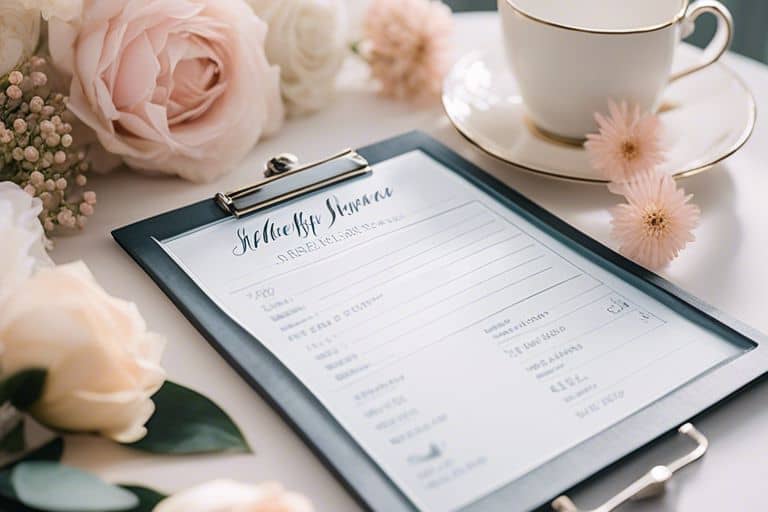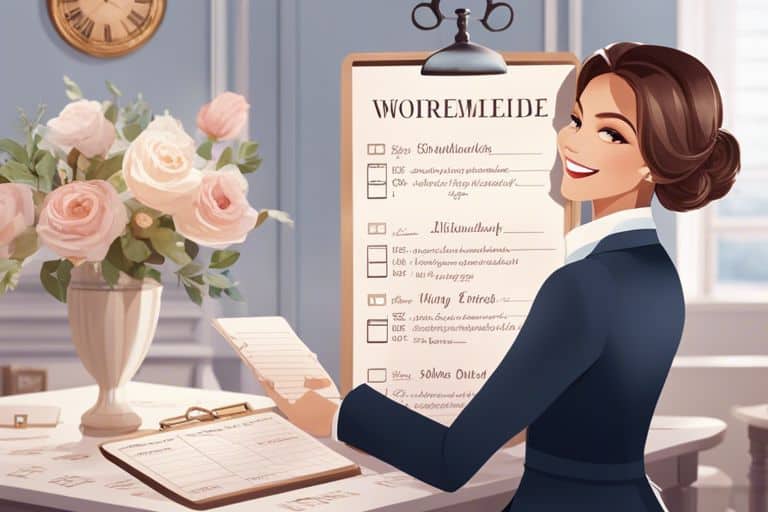Indubitably, crafting a wedding day timeline that runs smoothly is crucial for ensuring a stress-free and enjoyable celebration. The key to success lies in meticulous planning, clear communication, and attention to detail. By following 9 Wedding Day Timeline Rules Every Couple Should Follow, you can create a well-organised schedule that allows for seamless transitions and a memorable experience for all involved. From coordinating the arrival of the bridal party to scheduling the perfect moment for the first dance, every aspect should be carefully considered and accounted for. Timely communication with vendors, venues, and wedding party members is essential for avoiding potential hiccups and ensuring a smooth flow of events. With the right approach, your wedding day timeline can be a well-crafted orchestration that allows you to relax and fully immerse yourselves in the joyous occasion.
Key Takeaways:
- Communication is Key: Make sure to communicate with all the key players involved in the wedding day timeline, such as the photographer, caterer, and venue coordinator, to ensure everything runs smoothly.
- Allow Buffer Time: Factor in extra time for each part of the day, such as getting ready, travel between locations, and potential delays, to prevent any stress or rushing on the big day.
- Stay Flexible: Remember that unexpected changes or delays can occur, so it’s important to stay flexible and have a backup plan in place to keep the day running smoothly.
Getting Started with Your Timeline
Crafting a wedding day timeline can seem like a daunting task, but with the right approach, it can actually be quite straightforward. Start by considering the key elements of your wedding day and breaking them down into manageable segments, from getting ready in the morning to the final send-off in the evening.
The Basics of a Wedding Timeline
When creating your wedding day timeline, it’s important to start with the basics. Begin with the time of your ceremony and work backwards, allocating enough time for each activity. Consider travel time between locations, as well as any traditional customs or rituals you want to include.
Tips for Timing Your Ceremony Perfectly
Timing your ceremony perfectly is crucial for a smooth wedding day. Start by researching the average length of a ceremony and factor in any additional rituals or readings you want to incorporate. Consider the peak lighting for your outdoor ceremony and plan accordingly. The early afternoon is often a good time for an outdoor ceremony, as the light is typically flattering and not too harsh. The last thing you want is to be squinting into the sun or battling with unpredictable weather.
- Research the average length of a ceremony
- Factor in additional rituals or readings
- Consider the peak lighting for your outdoor ceremony
When timing your ceremony, it’s important to also consider any musical accompaniment or ceremonial exit you have planned. The flow of the day will be much smoother if these elements are carefully integrated into your timeline. The last thing you want is to feel rushed or too constricted by time on your special day.

Navigating the Reception Like a Pro
Scheduling Key Reception Events
When planning your wedding day timeline, it’s essential to carefully schedule key reception events to ensure everything runs smoothly. Make sure to communicate with your wedding coordinator or venue staff to determine ideal timings for the grand entrance, first dance, toasts, cake cutting, and other important moments. It’s important to coordinate these events with your photographer and videographer to ensure they capture every special moment.
Balancing Free Time and Structured Activities
One of the challenges in crafting a wedding day timeline is finding the right balance between free time and structured activities during the reception. While you want to give your guests the freedom to mingle and enjoy the celebration, it’s also important to have a planned schedule to keep the energy up and the party flowing. Consider incorporating fun activities like a photo booth or lawn games to keep your guests entertained during any downtime.
Striking the perfect balance between free time and structured activities will contribute to a relaxed and enjoyable atmosphere for your guests, ensuring they have a memorable experience at your wedding.
Special Considerations for Your Special Day
When crafting a wedding day timeline, there are several special considerations to keep in mind to ensure that everything runs smoothly. From accounting for photography and travel time to handling unexpected delays gracefully, it’s important to plan for every possible scenario.
Accounting for Photography and Travel Time
When planning your wedding day timeline, it’s essential to account for the time needed for photography sessions and travel between locations. Ensure that you allocate enough time for your photographer to capture all the special moments, and factor in travel time between the ceremony and reception venues, and any other locations where you plan to take photos. The last thing you want is to feel rushed or stressed on your special day, so be sure to plan for plenty of time to move between locations and capture beautiful photographs.
Handling Unexpected Delays Gracefully
Despite meticulous planning, unexpected delays can still occur on your wedding day. Whether it’s due to traffic, a late arrival from a vendor, or any other unforeseen circumstance, it’s important to handle these delays with grace and flexibility. Keep a positive mindset and embrace the inherent spontaneity of the day, knowing that everything will work out in the end. Having a buffer of extra time built into your timeline can also help to alleviate any stress caused by unexpected delays, giving you the freedom to navigate any challenges that may arise with ease.
It’s crucial to remember that your wedding day is a celebration of love and unity, and handling unexpected delays gracefully will ultimately allow you to focus on the joyous moments and create lasting memories with your loved ones.
Wrapping It All Up
Congratulations on successfully crafting a wedding day timeline that will ensure your special day runs smoothly! As you approach the big day, it’s important to finalise all the details and ensure everyone involved is on the same page to guarantee a seamless experience. Let’s wrap it all up and put the finishing touches on your wedding day timeline.
The Final Review of Your Wedding Day Timeline
As the wedding day approaches, it’s essential to conduct a final review of your wedding day timeline. Sit down with your partner, wedding coordinator, and any other key individuals involved in the event to go through every aspect of the timeline. Make sure everyone is aware of their roles and responsibilities and that there are contingency plans in place for any unforeseen circumstances. The final review is your chance to catch any potential hiccups and ensure that the timeline is as foolproof as possible.
The Role of Wedding Coordinators and Helpers
Wedding coordinators and helpers play a vital role in ensuring that your wedding day timeline runs smoothly. From keeping track of the schedule to liaising with vendors and managing any unexpected issues, their organisational skills and attention to detail are invaluable. Make sure to communicate with them effectively and provide them with all the necessary information to execute their roles flawlessly.
Remember, the role of wedding coordinators and helpers is to alleviate stress and allow you to fully enjoy your special day. Trust in their abilities and express your gratitude for their hard work and dedication.


Crafting a Wedding Day Timeline That Runs Smoothly
In conclusion, crafting a wedding day timeline that runs smoothly is essential for ensuring that your special day goes off without a hitch. By carefully scheduling each aspect of the day, from getting ready to the last dance, you can avoid unnecessary stress and ensure that everything runs seamlessly. Remember to build in some extra buffer time for unexpected delays and always communicate the timeline to your vendors, bridal party, and key family members to ensure that everyone is on the same page. With careful planning and attention to detail, you can create a wedding day timeline that allows you to relax and fully enjoy the magic of your special day. Congratulations, and best wishes for a beautiful and smooth-running wedding day!
FAQ
Q: What is a wedding day timeline?
A: A wedding day timeline is a detailed schedule that outlines the events and activities that will take place on the day of the wedding.
Q: Why is it important to have a well-crafted wedding day timeline?
A: A well-crafted wedding day timeline ensures that the day runs smoothly and all the key moments are captured without feeling rushed or stressful.
Q: Who should be involved in creating the wedding day timeline?
A: The bride and groom, along with their wedding planner and key vendors such as the photographer, caterer, and venue coordinator, should all be involved in creating the wedding day timeline.
Q: What key events should be included in the wedding day timeline?
A: Key events that should be included in the wedding day timeline are the ceremony start time, cocktail hour, dinner service, first dance, speeches, cake cutting, and any other special traditions or activities planned.
Q: How can I ensure that my wedding day timeline runs smoothly?
A: To ensure a smooth-running wedding day timeline, it’s important to allow buffer times between events, communicate clearly with all involved parties, and be flexible to accommodate any unexpected delays or changes.




